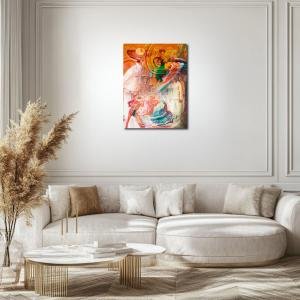Visions of Worship: Leonardo's The Adoration of the Magi Reimagined
"Visions of Worship: Leonardo's The Adoration of the Magi Reimagined" blends the unfinished brilliance of Leonardo’s 1481 masterpiece with modern conceptual elements. Centered on the Virgin Mary, Christ Child, and the Magi, the scene is imbued with dynamic energy, human emotion, and spiritual reverence. Architectural overlays symbolize the connection between heaven and earth, while the chaotic background reflects worldly struggles. Earthy Renaissance tones merge with contemporary hues, bridging past and present. This reinterpretation honors Leonardo’s mastery of light, anatomy, and narrative while inviting viewers to explore timeless themes of devotion, conflict, and transcendence.
Please see Below for Details…
Hotline Order:
Mon - Fri: 07AM - 06PM
404-872-4663
Leonardo da Vinci’s The Adoration of the Magi , created between 1481 and 1482, represents one of the most profound expressions of his early mastery of composition, movement, and narrative. Commissioned by the Augustinian monks of San Donato a Scopeto in Florence, the work remains unfinished, yet it is revered for its ambitious complexity and revolutionary approach to religious storytelling. This conceptual reimagining layers Leonardo’s original vision with modern elements, exploring themes of worship, architecture, and transcendence while retaining the ethereal quality of the Renaissance masterpiece.
The composition centers on the Virgin Mary and the Christ Child, surrounded by the Magi offering gifts. Leonardo’s use of chiaroscuro—a technique that blends light and shadow—lends an almost mystical quality to the scene, highlighting the divine figures amidst the chaos of the crowd. The foreground brims with dynamic energy as figures lean, kneel, and gesticulate, their expressions capturing a mix of reverence and human curiosity. Leonardo’s trademark attention to anatomical detail is evident in the lifelike poses and gestures, infusing the spiritual scene with profound humanity.
In this reinterpretation, the unfinished scaffolding of Leonardo’s original painting morphs into a modern architectural structure that spirals upward, symbolizing the connection between heaven and earth. This addition echoes Leonardo’s fascination with engineering and architecture, as seen in his countless designs for domes, machines, and structures. The juxtaposition of this skeletal framework with the vibrant tableau below evokes the tension between the tangible and the ethereal, a recurring theme in Leonardo’s work.
The background of the piece features a chaotic landscape of crumbling ruins, galloping horses, and battling soldiers, elements drawn directly from Leonardo’s original vision. These scenes symbolize the worldly turmoil that contrasts with the spiritual tranquility of the central figures. By including such vivid detail, Leonardo creates a narrative that extends beyond the nativity scene, reflecting the broader human condition of conflict, redemption, and hope.
The color palette in this work is particularly striking. Earthy tones of ochre, brown, and gold dominate the scene, grounding it in the Renaissance tradition while conveying a sense of warmth and divinity. The deeper shadows, rendered in rich blacks and grays, amplify the dramatic contrasts, enhancing the emotional weight of the composition. The inclusion of subtle modern hues—such as pale blues and metallic silvers in the architectural framework—bridges the past and the present, emphasizing the timeless relevance of the scene.
As an artist, reimagining The Adoration of the Magi provided an opportunity to delve into Leonardo’s innovative approach to narrative and composition. His ability to weave intricate human emotions into sacred scenes is unparalleled, and this reinterpretation seeks to honor that legacy while exploring new dimensions. The addition of architectural elements reflects Leonardo’s multidisciplinary genius, drawing connections between his religious, artistic, and scientific pursuits. The modern overlays invite viewers to contemplate how ancient stories resonate in contemporary contexts, blending tradition with innovation.
This artwork also captures the emotional essence of devotion and discovery. The Magi’s journey, marked by faith and curiosity, mirrors humanity’s quest for understanding and connection. The spiral structure, reaching toward the heavens, symbolizes the eternal search for divine truth, a theme that resonates deeply with Leonardo’s philosophical inquiries. The juxtaposition of light and shadow underscores the coexistence of clarity and mystery, inviting viewers to explore their interpretations of the scene.
The narrative layers in this piece echo Leonardo’s unfinished original, which leaves much to the imagination. By preserving this ambiguity, the artwork becomes a meditation on the process of creation itself—a theme that Leonardo, ever the experimenter, would have appreciated. The inclusion of chaotic and serene elements, both in the original and in this reinterpretation, reflects the dualities of human existence: order and chaos, faith and doubt, divinity and humanity.
This conceptual collage not only pays homage to Leonardo’s brilliance but also expands upon his themes, inviting viewers into a multidimensional exploration of art, faith, and innovation. It celebrates the enduring impact of The Adoration of the Magi while forging new connections between Renaissance ideals and modern artistic sensibilities.
Add your review
Your email address will not be published. Required fields are marked *
Please login to write review!
Looks like there are no reviews yet.










